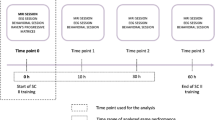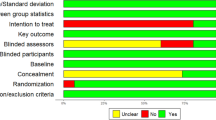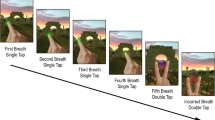Abstract
Video gaming is a highly pervasive activity, providing a multitude of complex cognitive and motor demands. Gaming can be seen as an intense training of several skills. Associated cerebral structural plasticity induced has not been investigated so far. Comparing a control with a video gaming training group that was trained for 2 months for at least 30 min per day with a platformer game, we found significant gray matter (GM) increase in right hippocampal formation (HC), right dorsolateral prefrontal cortex (DLPFC) and bilateral cerebellum in the training group. The HC increase correlated with changes from egocentric to allocentric navigation strategy. GM increases in HC and DLPFC correlated with participants’ desire for video gaming, evidence suggesting a predictive role of desire in volume change. Video game training augments GM in brain areas crucial for spatial navigation, strategic planning, working memory and motor performance going along with evidence for behavioral changes of navigation strategy. The presented video game training could therefore be used to counteract known risk factors for mental disease such as smaller hippocampus and prefrontal cortex volume in, for example, post-traumatic stress disorder, schizophrenia and neurodegenerative disease.
This is a preview of subscription content, access via your institution
Access options
Subscribe to this journal
Receive 12 print issues and online access
$259.00 per year
only $21.58 per issue
Buy this article
- Purchase on Springer Link
- Instant access to full article PDF
Prices may be subject to local taxes which are calculated during checkout




Similar content being viewed by others
References
Zimbardo P, Duncan N . The Demise of Guys: Why Boys Are Struggling and What We Can Do About It., TED conferences, 2012.
McGonigal J . Reality Is Broken. Penguin Books: New York, 2011 p 1.
Green CS, Bavelier D . Action video game modifies visual selective attention. Nature 2003; 423: 534–537.
Green CS, Bavelier D . Enumeration versus multiple object tracking: the case of action video game players. Cognition 2006; 101: 217.
Basak C, Boot WR, Voss MW, Kramer AF . Can training in a real-time strategy video game attenuate cognitive decline in older adults? Psychol Aging 2008; 23: 765–777.
Hertzog C, Kramer AF, Wilson RS, Lindenberger U . Enrichment effects on adult cognitive development: can the functional capacity of older adults be preserved and enhanced? Psychol Sci Public Interest 2008; 9: 1–65.
Boot WR, Kramer AF, Simons DJ, Fabiani M, Gratton G . The effects of video game playing on attention, memory, and executive control. Acta Psychol (Amst) 2008; 129: 387.
Boot WR, Blakely DP, Simons DJ . Do action video games improve perception and cognition? Front Psychol 2011; 2: 226.
Kühn S, Romanowski A, Schilling C, Lorenz R, Mörsen C, Seiferth N et al. The neural basis of video gaming. Transl Psychiatry 2011; 1: e53.
Kühn S, Gallinat J . Amount of lifetime video gaming is positively associated with entorhinal, hippocampal and occipital volume. Mol Psychiatry, (in press).
Draganski B, Gaser C, Busch V, Schuierer G, Bogdahn U, May A . Neuroplasticity: changes in grey matter induced by training. Nature 2004; 427: 311–312.
Lövden M, Wenger E, Mårtensson J, Lindenberger U, Bäckman L . Structural brain plasticity in adult learning and development. Neurosci Biobehav Rev 2013 (in press).
Burgess N . Spatial cognition and the brain. Ann NY Acad Sci 2008; 1124: 77–97.
DeCoteau WE, Kesner RP . A double dissociation between the rat hippocampus and medial caudoputamen in processing two forms of knowledge. Behav Neurosci 2000; 114: 1096–1108.
Gramann K, Müller HJ, Eick E-M, Schönebeck B . Evidence of separable spatial representations in a virtual navigation task. J Exp Psychol Hum Percept Perform 2005; 31: 1199–1223.
Ashburner J . A fast diffeomorphic image registration algorithm. NeuroImage 2007; 38: 95–113.
Hayasaka S, Nichols TE . Combining voxel intensity and cluster extent with permutation test framework. NeuroImage 2004; 23: 54–63.
Meng XL, Rosenthal R, Rubin DB . Comparing correlated correlation coefficients. Psychol Bull 1992; 111: 172–175.
DeLisi LE, Sakuma M, Tew W, Kushner M, Hoff AL, Grimson R . Schizophrenia as a chronic active brain process: a study of progressive brain structural change subsequent to the onset of schizophrenia. Psychiatry Res Neuroimaging 1997; 74: 129–140.
Scahill RI, Frost C, Jenkins R, Whitwell JL, Rossor MN, Fox NCA . Longitudinal study of brain volume changes in normal aging using serial registered magnetic resonance imaging. Arch Neurol 2003; 60: 989–994.
Raz N, Lindenberger U, Rodrigue KM . Regional brain changes in aging healthy adults: general trends, individual differences and modifiers. Cerebral Cortex 2005; 15: 1676–1689.
Raz N, Gunning-Dixon F, Head D, Rodrigue KM, Williamson A, Acker JD . Aging sexual dimorphism, and hemispheric asymmetry of the cerebral cortex: replicability of regional differences in volume. Neurobiol Aging 2004; 25: 377–396.
Lövden M, Schaefer S, Noack H, Bodammer NC, Kühn S, Heinze H-J et al. Spatial navigation training protects the hippocampus against age-related changes during early and late adulthood. Neurobiol Aging 2012; 33: 620., e9–620.e22.
Maguire EA, Gadian DG, Johnsrude IS, Good CD, Ashburner J, Frackowiak RS et al. Navigation-related structural change in the hippocampi of taxi drivers. Proc Natl Acad Sci USA 2000; 97: 4398–4403.
Moser MB, Moser EI . Functional differentiation in the hippocampus. Hippocampus 1998; 8: 608–619.
Burgess N . The hippocampus, space, and viewpoints in episodic memory. Q J Exp Psychol A 2002; 55: 1057–1080.
Postma A, Kessels R, van Asselen M . How the brain remembers and forgets where things are: the neurocognition of object–location memory. Neurosci Biobehav Rev 2008; 32: 1339–1345.
Klur S, Muller C, Pereira de Vasconcelos A, Ballard T, Lopez J, Galani R et al. Hippocampal-dependent spatial memory functions might be lateralized in rats: an approach combining gene expression profiling and reversible inactivation. Hippocampus 2009; 19: 800–816.
Kahn MC, Bingman VP . Lateralization of spatial learning in the avian hippocampal formation. Behav Neurosci 2004; 118: 333–344.
Kühn S, Gallinat J . Segregating cognitive functions within hippocampal formation. A quantitative meta-analysis on spatial navigation and episodic memory. Human Brain Mapping 2013 (in press).
O'Keefe J . A computational theory of the hippocampal cognitive map. Prog Brain Res 1990; 83: 301–312.
Hartley T, Maguire EA, Spiers HJ, Burgess N . The well-worn route and the path less traveled: distinct neural bases of route following and wayfinding in humans. Neuron 2003; 37: 877–888.
Jordan K, Schadow J, Wuestenberg T, Heinze H-J, Jäncke L . Different cortical activations for subjects using allocentric or egocentric strategies in a virtual navigation task. Neuroreport 2004; 15: 135.
Bird CM, Bisby JA, Burgess N . The hippocampus and spatial constraints on mental imagery. Front Hum Neurosci 2012; 6: 142.
Rodgers MK, Sindone JA III, Moffat SD . Effects of age on navigation strategy. Neurobiol Aging 2012; 33: 202., e15–202.e22.
Smith KS, Mahler SV, Pecina S, Berridge KC . Hedonic hotspots: generating sensory pleasure in the brain. In: Pleasures of the Brain. Oxford University Press: New York, 2010 p 1–25.
Gasbarri A, Packard MG, Campana E, Pacitti C . Anterograde and retrograde tracing of projections from the ventral tegmental area to the hippocampal formation in the rat. Brain Res Bull 1994; 33: 445–452.
Mizumori SJY, Puryear CB, Martig AK . Basal ganglia contributions to adaptive navigation. Behav Brain Res 2009; 199: 32–42.
Lisman J, Grace AA, Düzel E . A neoHebbian framework for episodic memory; role of dopamine-dependent late LTP. Trends Neurosci 2011; 34: 536–547.
Han DH, Bolo N, Daniels MA, Arenella L, Lyoo IK, Renshaw PF . Brain activity and desire for Internet video game play. Compr Psychiatry 2011; 52: 88–95.
Miller EK, Cohen JD . An integrative theory of prefrontal cortex function. Annu Rev Neurosci 2001; 24: 167–202.
Cieslik EC, Zilles K, Caspers S, Roski C, Kellermann TS, Jakobs O et al. Is there ‘one’ DLPFC in cognitive action control? Evidence for heterogeneity from co-activation-based parcellation. Cerebral Cortex 2013 (in press).
Janzen G, Jansen C . A neural wayfinding mechanism adjusts for ambiguous landmark information. NeuroImage 2010; 52: 364–370.
Basak C, Voss MW, Erickson KI, Boot WR, Kramer AF . Regional differences in brain volume predict the acquisition of skill in a complex real-time strategy videogame. Brain Cogn 2011; 76: 407–414.
Kennedy KM, Raz N . Age sex and regional brain volumes predict perceptual-motor skill acquisition. Cortex 2005; 41: 560–569.
Otani S, Daniel H, Roisin M-P, Crepel F . Dopaminergic modulation of long-term synaptic plasticity in rat prefrontal neurons. Cerebral Cortex 2003; 13: 1251–1256.
Jay TM . Dopamine: a potential substrate for synaptic plasticity and memory mechanisms. Prog Neurobiol 2003; 69: 375–390.
Thierry AM, Blanc G, Sobel A, Stinus L, Glowinski J . Dopaminergic terminals in the rat cortex. Science 1973; 182: 499–501.
Grasby PM, Koepp MJ, Gunn RN, Lawrence AD, Cunningham VJ, Dagher A et al. Evidence for striatal dopamine release during a video game. Nature 1998; 393: 266–268.
Goto Y, Yang CR, Otani S . Functional and dysfunctional synaptic plasticity in prefrontal cortex: roles in psychiatric disorders. Biol Psychiatry 2010; 67: 199–207.
Manto M, Bower JM, Conforto AB, Delgado-García JM, da Guarda SNF, Gerwig M et al. Consensus paper: roles of the cerebellum in motor control—the diversity of ideas on cerebellar involvement in movement. Cerebellum 2012; 11: 457–487.
Grodd W, Hülsmann E, Lotze M, Wildgruber D, Erb M . Sensorimotor mapping of the human cerebellum: fMRI evidence of somatotopic organization. Human Brain Mapping 2001; 13: 55–73.
Desmond JE, Gabrieli JD, Wagner AD, Ginier BL, Glover GH . Lobular patterns of cerebellar activation in verbal working-memory and finger-tapping tasks as revealed by functional MRI. J Neurosci 1997; 17: 9675–9685.
Kühn S, Romanowski A, Schilling C, Banaschewski T, Barbot A, Barker GJ et al. Manual dexterity correlating with right lobule VI volume in right-handed 14-year-olds. NeuroImage 2012; 59: 1615–1621.
Stoodley CJ, Schmahmann JD . Functional topography in the human cerebellum: a meta-analysis of neuroimaging studies. NeuroImage 2009; 44: 489–501.
Borecki L, Tolstych K, Pokorski M . Computer games and fine motor skills. In: Advances in Experimental Medicine and Biology, Lambris JD (ed). Springer: Dordrecht, The Netherlands, 2012 pp 343–348.
Berg P, Becker T, Martian A, Primrose KD, Wingen J . Motor control outcomes following Nintendo Wii use by a child with Down syndrome. Pediatr Phys Ther 2012; 24: 78–84.
Kennedy AM, Boyle EM, Traynor O, Walsh T, Hill ADK . Video gaming enhances psychomotor skills but not visuospatial and perceptual abilities in surgical trainees. J Surg Educ 2011; 68: 414–420.
Kühn S, Gallinat J . Gray matter correlates of posttraumatic stress disorder: a quantitative meta-analysis. Biol Psychiatry 2013; 73: 70–74.
Woon FL, Sood S, Hedges DW . Hippocampal volume deficits associated with exposure to psychological trauma and posttraumatic stress disorder in adults: a meta-analysis. Prog Neuro-Psychopharmacol Biol Psychiatry 2010; 34: 1181–1188.
Ferreira LK, Diniz BS, Forlenza OV, Busatto GF, Zanetti MV . Neurostructural predictors of Alzheimer's disease: a meta-analysis of VBM studies. Neurobiol Aging 2011; 32: 1733–1741.
Shi F, Liu B, Zhou Y, Yu C, Jiang T . Hippocampal volume and asymmetry in mild cognitive impairment and Alzheimer's disease: meta-analyses of MRI studies. Hippocampus 2009; 19: 1055–1064.
Kühn S, Musso F, Mobascher A, Warbrick T, Winterer G, Gallinat J . Hippocampal subfields predict positive symptoms in schizophrenia: first evidence from brain morphometry. Transl Psychiatry 2012; 2: e127.
Shepherd AM, Laurens KR, Matheson SL, Carr VJ, Green MJ . Systematic meta-review and quality assessment of the structural brain alterations in schizophrenia. Neurosci Biobehav Rev 2012; 36: 1342–1356.
Haier RJ, Karama S, Leyba L, Jung RE . MRI assessment of cortical thickness and functional activity changes in adolescent girls following three months of practice on a visual-spatial task. BMC Res Notes 2009; 2: 174.
Acknowledgements
We are grateful for the assistance of Sonali Beckmann operating the scanner as well as David Steiniger and Kim-John Schlüter for testing the participants.
Author information
Authors and Affiliations
Corresponding author
Ethics declarations
Competing interests
The authors declare no conflict of interest.
Rights and permissions
About this article
Cite this article
Kühn, S., Gleich, T., Lorenz, R. et al. Playing Super Mario induces structural brain plasticity: gray matter changes resulting from training with a commercial video game. Mol Psychiatry 19, 265–271 (2014). https://doi.org/10.1038/mp.2013.120
Received:
Accepted:
Published:
Issue Date:
DOI: https://doi.org/10.1038/mp.2013.120
Keywords
This article is cited by
-
New insight of exercise on dementia; combinatory effects of physical and cognitive exercise
Molecular & Cellular Toxicology (2024)
-
Rehabilitation of amblyopia using a digital platform for visual training combined with patching in children: a prospective study
Graefe's Archive for Clinical and Experimental Ophthalmology (2024)
-
Effects of task-specific strategy on attentional control game training: preliminary data from healthy adults
Current Psychology (2024)
-
Association between real-time strategy video game learning outcomes and pre-training brain white matter structure: preliminary study
Scientific Reports (2022)
-
The impact of video gaming on cognitive functioning of people with schizophrenia (GAME-S): study protocol of a randomised controlled trial
BMC Psychiatry (2021)



